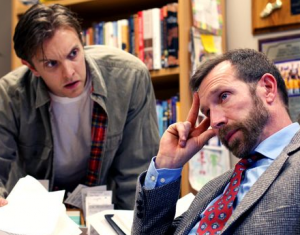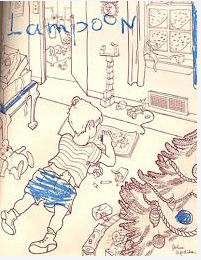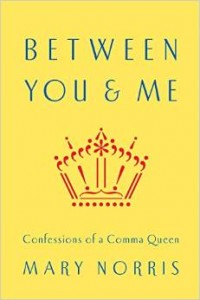 Today, March 11, 2015, unabashed Updike fan Garrison Keillor featured another poem by the author on The Writer’s Almanac, his American Public Media website.
Today, March 11, 2015, unabashed Updike fan Garrison Keillor featured another poem by the author on The Writer’s Almanac, his American Public Media website.
Here is “The Blessing.”

 Today, March 11, 2015, unabashed Updike fan Garrison Keillor featured another poem by the author on The Writer’s Almanac, his American Public Media website.
Today, March 11, 2015, unabashed Updike fan Garrison Keillor featured another poem by the author on The Writer’s Almanac, his American Public Media website.
Here is “The Blessing.”
Finalists for the L.A. Times Book Prizes were announced today, and Adam Begley’s Updike is one of five books in the running to win the award for biography. The others are Robert M. Dowling’s Eugene O’Neill: A Life in Four Acts, Kirstin Downey’s Isabella: The Warrior Queen, Stephen Kotkin’s Stalin: Volume 1 – Paradoxes of Power 1878-1928, and Andrew Roberts’ Napoleon: A Life.
It remains to be seen whether the lack of a colon in Begley’s title will help or hurt.
The other nominees can be found here: “T.C. Boyle, LeVar Burton lead L.A. Times Book Prizes.”
 Wes Driver‘s stage adaptation of Roger’s Version, which was named Nashville Scene‘s Best Original Drama 2014, has been nominated for the American Theatre Critics Association’s ATCA/Steinberg New Play Award.
Wes Driver‘s stage adaptation of Roger’s Version, which was named Nashville Scene‘s Best Original Drama 2014, has been nominated for the American Theatre Critics Association’s ATCA/Steinberg New Play Award.
Driver, who is Blackbird Theater’s artistic director, premiered Roger’s Version on May 30, 2014 at the Blackbird Theater in Nashville, Tenn.
“Stage version of Roger’s Version lauded”
“Preview of staged Roger’s Version applauds director and writer”
We received the following note and accompanying materials from Michael Updike, who notes that the bags that Paul Moran famously hauled away from his father’s Beverly Farms curbside contained much more than trash, and offers an important donation if Moran will donate his part to The John Updike Childhood House:
Dear John Updike Society,
As you know my father, as a young aspiring cartoonist, sent off fan letters asking established cartoonist for original artwork. I have enclosed a letter to Harold Gray of The Blondie strip that has miraculously survived.
The most famous successes to these letters were original works by Saul Stienberg and James Thurber. These were in the exhibit of JHU items at the Boston conference and mentioned in Due Consideration P.612 . Another bit of booty was this original Mickey Finn strip by Lank Leonard. It is signed in cartoon capitals “-TO JOHN UPDIKE-WITH ALL THE BEST FROM Lank Leonard”. It has been kicking around our house ever since I remember. At some point (circa mid seventies) the last three panels went missing. The tape had long given way. I assumed they were lost for good to the far corners of the house or thrown out. Recently, to my great surprise, the lost panels showed up on The Other John Updike Archive. I can only assume that my father took them during the divorce and they went to the trash shortly before or after his demise. My siblings and I would love to see the two parts of this comic reunited after forty years of separation. We would happily donate our half of the work to the John Updike House if the other owner would donate as well.
Thanks very Much
Michael
January 2, 1948
Mr. Harold Gray
c/o New York News Syndicate
220 East 42nd Street
New York 17, New York
Dear Mr. Gray:
I don’t suppose that I am being original when I admit that ORPHAN ANNIE is, and has been for a long time, my favorite comic strip. There are many millions like me. The appeal of your comic strip is an American phenomenon that has affected the public for many years, and will, I hope, continue to do so for many more.
I admire the magnificent plotting of Annie’s adventures. They are just as adventure strips should be–fast moving, slightly macabre (witness Mr. Am), occasionally humorous, and above all, they show a great deal of the viciousness of human nature. I am very fond of the gossip-in-the-street scenes you frequently use. Contrary to comic-strip tradition, the people are not pleasantly benign, but gossiping, sadistic, and stupid, which is just as it really is.
Your villains are completely black and Annie and crew are practically perfect, which is as it should be. To me there is nothing more annoying in a strip than to be in the dark as to who is the hero and who the villain. I like the methods in which you polish off your evil-doers. One of my happiest moments was spent in gloating over some hideous child (I forget his name) who had been annoying Annie toppled into the wet cement of a dam being constructed. I hate your villains to the point where I could rip them from the paper. No other strip arouses me so. For instance, I thought Mumbles was cute.
Your draughtsmanship is beyond reproach. The drawing is simple and clear, but extremely effective. You could tell just by looking at the faces who is the trouble maker and who isn’t, without any dialogue. The facial features, the big, blunt fingered hands, the way you handle light and shadows are all excellently done. Even the talk balloons are good, the lettering small and clean, the margins wide, and the connection between the speaker and his remark wiggles a little, all of which, to my eye, is as artistic as you can get.
All this well-deserved praise is leading up to something, of course, and the catch is a rather big favor I want you to do for me. I need a picture to alleviate the blankness of one of my bedroom walls, and there is nothing that I would like better than a little momento of the comic strip I have followed closely for over a decade. So–could you possibly send me a little autographed sketch of Annie that you have done yourself? I realize that you probably have some printed cards you send to people like me, but could you maybe do just a quick sketch by yourself? Nothing funny, just what you have done yourself. I you cannot do this (and I really wouldn’t blame you) will you send me anything you like, perhaps an original comic strip? Whatever I get will be appreciated, framed, and hung.
Sincerely,
(Signed, ‘John Updike’)
John Updike
Elverson P. D. #2
Moran did the Updike world a huge favor when he saved all those bags from the dumpster, and the Society would have loved to bid on them. They would have made for terrific exhibits for The John Updike Childhood Home at 117 Philadelphia Avenue in Shillington, Pa., where Updike said his “artistic eggs were hatched.” Hopefully they’ll end up in a public, not private, collection.
The John Updike Society is committed to building a world-class author home museum, and anyone with materials to donate or offer for sale should contact Society president James Plath, jplath@iwu.edu. We are a 501c3 non-profit organization so all donations are tax deductible, and all donors will be acknowledged at the point of exhibit. We are also planning a donor wall where all who donate $500 or more, cash or in-kind, will be honored.
Because The John Updike Society went very quickly from an author society of 35 members to a 501 c 3 non-profit organization of 250+ members with a six-figure budget and the responsibility of restoring and maintaining The John Updike Childhood Home, the board decided at their October 4, 2014 board meeting to alter the composition and election structure of the board to reflect current sound practices among non-profits of similar size and mission. It was decided that two new board members would be added, with a nominating committee composed of board members bringing forth names of candidates who fit the current needs of the board. Board members then voted and extended an invitation to the two who received the most votes: Biljana Dojčinović, Associate Professor, Dept. of Comparative Literature and Theory of Literature, Faculty of Philology, University of Belgrade, Serbia, and Robert Luscher, Professor of English, University of Nebraska at Kearney. Both accepted and begin serving three-year terms immediately, joining current board members Jim Plath (president), Jim Schiff (vice-president and editor of The John Updike Review), Peter Bailey (secretary), Marshall Boswell (Treasurer), and directors Sylvie Mathé and Don Greiner.
At the October meeting, the board also determined that two positions should be converted into general membership seats, to be decided by an election in which all members vote. The first three-year position to be filled is the seat vacated by Jack De Bellis, who resigned last year in order to make way for “new blood.” The board is grateful for De Bellis’s tireless service and will miss his presence. But he will continue to advise on an informal basis. Members soon will receive calls for nomination from the secretary regarding the election.
 Biljana Dojčinović is the director of the national project Кnjiženstvo—theory and history of women’s writing in Serbian until 1915 and editor-in-chief of Knjiženstvo, A Journal in Literature, Gender and Culture. She has been a member of The John Updike Society since its founding and a member of the editorial board of The John Updike Review since 2010. Her Ph.D. was focused on the narrative strategies in John Updike’s novels, and in 2007 she published a monograph in Serbian on Cartographer of the Modern World: The Novels of John Updike. She is also the author of numerous essays on Updike’s works and other topics, as well as five more academic books.
Biljana Dojčinović is the director of the national project Кnjiženstvo—theory and history of women’s writing in Serbian until 1915 and editor-in-chief of Knjiženstvo, A Journal in Literature, Gender and Culture. She has been a member of The John Updike Society since its founding and a member of the editorial board of The John Updike Review since 2010. Her Ph.D. was focused on the narrative strategies in John Updike’s novels, and in 2007 she published a monograph in Serbian on Cartographer of the Modern World: The Novels of John Updike. She is also the author of numerous essays on Updike’s works and other topics, as well as five more academic books.
 Rob Luscher is the author of John Updike: A Study of the Short Fiction and “Updike’s Olinger Stories: New Light among the Shadows. He has also published essays on Updike and his short fiction in the Dictionary of Literary Biography, the Blackwell Companion to the American Short Story, Eureka Studies in Short Fiction, and The John Updike Review. Beyond Updike, his scholarship focuses on the short story sequence, with published essays on volumes of short fiction by Ernest Gaines, Mary Wilkins Freeman, Clark Blaise, and Robert Olen Butler. He has been a member of The John Updike Society since its founding, and in addition to teaching at the University of Nebraska at Kearney he also serves as Faculty Coordinator of the Thompson Scholars Learning Community.
Rob Luscher is the author of John Updike: A Study of the Short Fiction and “Updike’s Olinger Stories: New Light among the Shadows. He has also published essays on Updike and his short fiction in the Dictionary of Literary Biography, the Blackwell Companion to the American Short Story, Eureka Studies in Short Fiction, and The John Updike Review. Beyond Updike, his scholarship focuses on the short story sequence, with published essays on volumes of short fiction by Ernest Gaines, Mary Wilkins Freeman, Clark Blaise, and Robert Olen Butler. He has been a member of The John Updike Society since its founding, and in addition to teaching at the University of Nebraska at Kearney he also serves as Faculty Coordinator of the Thompson Scholars Learning Community.
 The current owners of a grand Georgian home on the North Shore where Updike lived for years have opened the house for a Boston Common Magazine tour, complete with three photos of the Haven Hill house as it looks now:
The current owners of a grand Georgian home on the North Shore where Updike lived for years have opened the house for a Boston Common Magazine tour, complete with three photos of the Haven Hill house as it looks now:
“A Tour of John Updike’s Former North Shore Home”
The article, written by Alexandra Hall, begins with a quote from Updike: “‘Every novelist becomes, to a degree, an architect,’ wrote the revered John Updike in 1985. ‘A novel itself is, of course, a kind of dwelling, whose spaces open and constrict, foster display or concealment, and resonate from room to room.’
“It’s a telling analogy from a man who viewed both his writings and his homes as such personal endeavors. And when design consultant Suzanne Eliastam was approached by the new owners of one of the late author’s most beloved abodes—a grand Georgian home on the North Shore named Haven Hill, where Updike lived for hears—she took that sentiment to heart in redecorating it.”
We’re told that one of its “most impressive pieces is something Updike left behind: a huge mirror, almost 10 feet tall, framed in wood with gold leaf. It shared space in the living room with the original fireplace, both of which were left untouched while the room was renovated.”
 At one time Paul Moran said he wasn’t interested in the money, but just wanted to find a good home for the Updike materials he famously scrounged from the author’s curbside in Beverly Farms.
At one time Paul Moran said he wasn’t interested in the money, but just wanted to find a good home for the Updike materials he famously scrounged from the author’s curbside in Beverly Farms.
That time has apparently passed. Now he’s wanting $250,000 for the contents of all the trash bags he hauled away, with the blog he used to showcase the items—The Other John Updike Archive—thrown in. Moran says that bids will be accepted until 5 p.m. on March 31, 2015.
It would have been nice to have those materials for The John Updike Childhood Home at 117 Philadelphia Avenue, but $250,000 is an insane amount of money . . . more than the Society paid for the house itself.
Still, if there’s an extremely wealthy person out there who has enough disposable income to spend it on disposed-of Updike items, the Society, a 501 c 3 non-profit, would be happy to be the beneficiary!
Here’s a link to the post announcing the sale, with detailed visuals of what we may never see again.
 The Guardian Books Blog has been writing their version of “A brief survey of the short story,” and this past week writer Chris Power got around to John Updike. He writes that “there is enough Updike, with enough difference in quality, that you could plausibly read a lot of him without encountering a dud, and read just as much in another, unluckier direction without encountering anything particularly good. Few writers are more in need of a well-chosen collection of selected stories.”
The Guardian Books Blog has been writing their version of “A brief survey of the short story,” and this past week writer Chris Power got around to John Updike. He writes that “there is enough Updike, with enough difference in quality, that you could plausibly read a lot of him without encountering a dud, and read just as much in another, unluckier direction without encountering anything particularly good. Few writers are more in need of a well-chosen collection of selected stories.”
He’s right, actually. A single volume of “greatest hits” would be a sure contender for another Pulitzer Prize and make Updike the all-time leader in fiction Pulitzers. Right now he’s tied with Booth Tarkington and William Faulkner as the only American writers to win the prize twice.
Power, who says the “best place to begin is in Olinger,” concludes with a quote from Updike: “‘I cannot greatly care what critics say of my work,’ Updike said in 1968. ‘If it is good, it will come to the surface in a generation or two and float, and if not, it will sink.’ Much of his work, despite the nearly unfailing presence of a memorable simile, or pitch-perfect phrase, will disappear in time. Some—a small amount by Updike’s standards perhaps, but more than many can hope for—deserve the permanence we ourselves are denied.”
 In an essay titled “Holy Writ: Learning to love the house style,” Mary Norris writes a “personal history” that covers her first job and how she came to be a copy editor for The New Yorker. She also talks about some of the writers she admired, among them, John Updike:
In an essay titled “Holy Writ: Learning to love the house style,” Mary Norris writes a “personal history” that covers her first job and how she came to be a copy editor for The New Yorker. She also talks about some of the writers she admired, among them, John Updike:
“And there were writers whose prose came in so highly polished that I couldn’t believe I was getting paid to read them: John Updike, Pauline Kael, Mark Singer, Ian Frazier! In a way, these were the hardest, because the prose lulled me into complacency. They transcended the office of the copy editor. It was hard to stay alert for opportunities to meddle in an immaculate manuscript, yet if you missed something you couldn’t use that as an excuse. The only thing to do was style the spelling, and even that could be fraught. . . .
“I was on the copydesk when John McPhee’s pieces on geology were set up. I tried to keep my head. There was not much to do. McPhee was like John Updike, in that he turned in immaculate copy. Really, all I had to do was read,” she writes.
Norris began working at The New Yorker in 1978 and has been a query proofreader at the magazine since 1993. Her book, Between You & Me: Confessions of a Comma Queen, will be published by W. W. Norton & Co. on April 6, 2015.